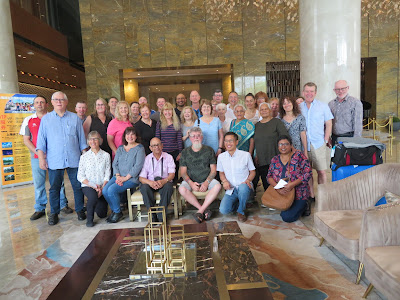நம் எல்லோருக்கும் உடல் என்று ஒன்று இருப்பது போல் மனம் என்றும் ஒன்று
இருக்கிறது. அதை பார்க்காவிட்டாலும்
உணர்கிறோம், உபயோகிக்கிறோம். அது ஒரு கரணம்,
அந்தக்கரணம் எனப்படும் கருவி. கண், காது, மூக்கு, நாக்கு, சருமம், ஆகிய ஐந்து ஞானேந்திரியங்களின் கூட்டில் பிரமாணமாக, அறிவைக் கொடுக்கும் கருவியாக, இருக்கிறது. மற்றும்
அது கர்த்தாவாக, செயலாற்றும் கருவியாகவும், போக்தாவாக, செயலை அனுபவிக்கும் கருவியாகவும், இருக்கிறது. கோபம், மோகம்,
போன்ற குணங்களின் அதிக்கத்தில் ஒருவர் செயலாற்றும் பொழுது அங்கு மனமே கர்த்தவாக
இருக்கிறது, அறிவு அங்கு மனதிற்கு அடங்கிப்போகிறது. கவலை, வருத்தம், மகிழ்ச்சி இவற்றை அனுபவிக்கும்போது
போக்தாவாக இருக்கிறது. இப்படிப்பட்ட மனம், உடல் போன்று பருப்பொருள் (gross) அல்ல. அது ஒரு
நுண்பொருள் (subtle). இந்த மனம் சாதாரணமாக மேல்மனம் (Conscious mind), ஆழ்மனம் (subconscious mind) என்ற இரண்டு நிலைகளில் இருந்து
செயல்படுகிறது. இது தவிர அதீத உணர்வு மனம்
(supra-conscious mind) என்று ஒரு நிலை யோகிகளுக்கும்
சித்தர்களுக்கும் சாத்தியமாகிறது. அதை
உபயோகித்து அவர்கள் பிரபஞ்சமனத்துடன் (Universal mind) தங்கள் தியான சக்தியினால் தொடர்பு கொண்டு,
அற்புதங்கள் நிகழ்த்துகிறார்கள்.
மேல்மனதை விழிப்புமனம் என்றும் சொல்லலாம். நாம் விழித்துக்
கொண்டிருக்கும்பொழுது உலகத்துடன்
உறவாடுவது இந்த மனமே. ஆழ்மனம் மேல்மன
நிகழ்வுகளை பதிவுகளாக உள்வாங்கிக்கொண்டு சேமித்து வைக்கிறது. இந்த பதிவுகளின்
தாக்கம் வாசனைகளாக,
சம்ஸ்க்காரங்களாக, மேல்மனச் செயல்பாடுகளை பாதிக்கிறது. ஆழ்மனம்
உடலுடன் மரிப்பதில்லை, மாறாக சூக்சும உடலுடன் அடுத்த
பிறவிக்கு பயணிக்கிறது என்று இந்துமத சாஸ்திரங்கள் சொல்கின்றன.. வாசனைகள்
இருக்கும் வரை பிறப்பு இறப்பு சுழற்சியிலிருந்து உயிருக்கு விடுதலை இல்லை என்றும்
சொல்கின்றன.
ஆசைகளால் மனிதனை ஸம்ஸாரத்தில் கட்டும் மனமே நற்பண்புகள் வளர்த்து அறிவின் துணை
கொண்டு ஸம்ஸாரத்தளையிலிருந்து விடுபட, மோக்ஷம் பெற, சாதனமுமாகிறது. இது எப்படியென்றால்
காற்று வீசி நகரும் மேகம் சூரியனை மறைக்கிறது. அதே காற்றுதான் மறைக்கும் மேகத்தை
கலைத்து சூரியன் தெரியவும் செய்கிறது. இந்த மனம் மனிதன் வசம் இருந்தால், அதாவது அவன் அறிவு காட்டும் வழியில், மனிதன் சென்றால்.
அவன் தேவனாக உயரலாம், மாறாக மனம் போகும் பாதையில் மனிதன் சென்றால், அவன் அசுரனாக வீழலாம். ஆக பண்படாத மனமே
பந்த காரணம், பண்பட்ட மனமோ மோக்ஷ சாதனம். மலங்களை நீக்கி மனதை பண்படுத்தி பந்த காரணத்தை
மோக்ஷ சாதனமாக மாற்ற பதஞ்சலி முனிவர் தன் “யோக சூத்திரம்”
என்ற நூலிலே யமம், நியமம் என்ற தலைப்பிலே பத்து சாதனைகளைக் கூறுகிறார், யமம் தவிர்க்கவேண்டிய வேண்டியவைகளையும் நியமம்
கடைப்பிடிக்க வேண்டியவைகளையும் பட்டியலிடுகின்றன. இவற்றை சுவாமி பரமார்த்தானந்தா “ஹிந்து மதத்தின்
பத்து கட்டளைகள்” என்று கூறுவார். அந்த
பத்து கட்டளைகளை வரிசைப்படுத்தி, சிறிது விரிவாகப்
பார்ப்போம்.
முதல் ஐந்து, யமத்தில்
அடங்கும். இவை தவிர்த்தலை கொண்டது.
ஹிம்சையைத் தவிர்த்தல். – அஹிம்சை. மனதாலோ வாக்காலோ உடலாலோ எந்த ஜீவராசியையும்
எந்த விதத்திலும் எப்பொழுதும் துன்புறுத்தாமை அஹிம்சை. அடித்தல், உதைத்தல், சித்திரவதை செய்தல், கொல்லுதல் உடலால் ஹிம்சை செய்வது. சொற்களால் காயப்படுத்துவது வாக்கால்
ஹிம்சை செய்வது. மௌனமாக சபிப்பது, மனதிற்க்குள் திட்டுவது, மனதால் ஹிம்சை செய்வது. கோபம், வெறுப்பு, பொறாமை, பழிவாங்கும் எண்ணம்,
போன்ற எதிர்மறை (negative) எண்ணங்களும், கவனக்குறைவும் ஹிம்சைக்கு காரணமாகின்றன. ஆனால் மற்றவரின் நன்மைக்காக செய்யப்படும்
தேவையான அளவு ஹிம்சை, ஹிம்சையில் அடங்காது. உதாரணமாக நோயை குணப்படுத்த செய்யப்படும் அறுவை
சிகிச்சை.
பொய் பேசாதிருத்தல் - சத்தியம். இதுவே
வாய்மை எனப்படும். அஹிம்சையைப் போல் இதையும் பிறருக்கு நன்மை தருவது என்பதுடன்
சேர்த்துப் பார்க்க வேண்டும்.
பொய்மையும் வாய்மை இடத்த,
புரை தீர்த்த
நன்மை பயக்கும் எனின்.
என்ற வள்ளுவர் குறளை இங்கு நினைவு கூற வேண்டும். ஆக சத்தியத்தை மூன்று பிரிவாகச் சொல்லலாம்.
1) யாதொரு
தீமையும் விளையாது என்றால் உள்ளதை உள்ளபடி உரைத்தல்.
2)
துயரத்தையோ
தீங்கையோ தரும் என்றால் மறைத்தல்.
3)
அதனால்
நன்மை விளையும் என்றால் மாற்றிக்கூறல்.
பிறர் பொருளை அபகரிக்காமை – அஸ்தேயம்.
களவாமை. பிறர் உழைப்பு, பிறர் அறிவு இவற்றிற்கு தகுந்த சன்மானம் (compensation)
கொடுக்காமல் பயன்படுத்துவதும் (copyright infringement) ஒரு வகை திருட்டே.
சரீர ஒழுக்கம் – பிரம்மச்சரியம்.
இது ஆசிரமத்திற்கு ஆசிரமம் வேறுபடும். பிரம்மச்சரிய ஆசிரமத்தில் எளிய
வாழ்வு, குரு சேவை, உணவுக் கட்டுப்பாடு, உடல் ஒழுக்கம் இவைகளையும் கிருஹஸ்த ஆசிரமத்தில் அதர்ம வழியில் சரீர
இன்பம் துய்க்காமையையும், சன்னியாச ஆசிரமத்தில் சரீர இன்பம்
முழுமையாக தவிர்த்தலையும் பிரம்மச்சரியம்
குறிக்கும்.
தேவைக்கு அதிகமாக
சேர்த்துக் கொள்ளாமை - அபரிக்கிரஹம் –. லோப குணம், எதிர்
காலத்தைப் பற்றிய பயம், இறைவன் கருணையில் நம்பிக்கையின்மை, பாதுகாப்பின்மை உணர்வு இவையே இதற்க்கு கரணமாகிறது.
மேலே பார்த்த ஐந்தும் யமத்தில் அடங்கும்.
இவை ஒவ்வொன்றையும் ஒரு விரதம் என்றும், ஐந்தையும் சேர்த்து கடைப்பிடிப்பது மகாவிரதம் என்றும் சொல்லப்படுகிறது. அடுத்து வரும் ஐந்தும் நியமத்தில் அடங்கும்.
இவை கடைப்பிடிக்க வேண்டிய பண்புகள்.
செளசம் – தூய்மை. இதுவே
புறத்தூய்மை, அகத்தூய்மை என்று
இரண்டாக பார்க்கப்படுகிறது. புறத்தூய்மை நம் உடலை, உடைமைகளை, சுற்றுப்புறத்தை தூய்மையாக வைத்துக் கொள்ளுதல். அகத்தூய்மை என்பது நம்
மனதில் துர்க்குணங்களை தவிர்த்து நற்பண்புகளைப் பேணல். பகவத்கீதை பாஷையில்
ஆசுரிசம்பத்து தவிர்த்து தெய்வீசம்பத்து
பேணவேண்டும். அகத்தூய்மைக்கு சத்சங்கம் ஒரு முக்கிய சாதனம்.
சந்தோஷம் – திருப்தி. திருப்தி
இருந்தால் பொறாமை வராது, லோபம்
இருக்காது. மற்றவருடன் ஒப்பிட்டு நோக்குதலே திருப்தியின்மைக்கு ஒரு காரணமாகிறது.
போதுமென்ற மனமே பொன் செய்யும் மருந்து என்ற பழமொழியை எப்போதும் நினைவில் கொள்ள
வேண்டும்.
தபம் - காட்டிலே போய் புலன் அடக்கிச் செய்வது அல்ல, மன, உடல்
கட்டுப்பட்டுக்காக விரும்பி சுகத்தை துறந்து கஷ்டத்தை ஏற்றுக் கொள்ளும்
சாதனை. தபம் என்றால் உருக்குதல். மனதை, உடலை உருக்கி மேம்படுத்தும் சாதனைகள் தபத்தில் அடங்கும். இதை சாத்வீகம், ராஜசம், தாமசம் என்று தரப்படுத்தலாம். உடலை துன்புறுத்தாத சாத்வீக சாதனையாக இதை செய்ய வேண்டும்.
ஸ்வாத்யாயம் – சாஸ்திரம்
படித்தல், பாராயணம் செய்தல்,
திருக்குறள், திருவாசகம் போன்ற அறநூல்களைப் படித்தல், மனனம் செய்தல், மகாத்மாக்களின் வரலாறுகளைப்
படித்தல், இவை ஸ்வாத்யாயத்தில் அடங்கும்.
ஈஸ்வவரபிரநிதானம் – எந்த
ஒரு அனுபவத்தையும் எதிர்ப்பு இன்றி அதை இறைவனின் பிரசாதம் என்று முழுமனதோடு
ஏற்றுக்கொள்ளல். இதை ஏற்பு பாவனை அல்லது
சரணாகதி என்று சொல்லலாம். இது கர்மயோகம், பக்தியோகம் கலந்த சாதனை.
யமமும் நியமமும் பதஞ்சலி முனிவர் கூறும்
அஷ்டாங்கயோகத்தில் ஒரு அங்கம். அடுத்த அங்கமான பிரணாயாமம், யம நியமத்தால் நெறிப்படுத்தப்பட்ட மனதை
அமைதிப்படுத்த ஒரு குறுக்கு வழியாகிறது. அமைதியான மனத்தையே தியானத்தில் ஈடுபடுத்த
இயலும். இதை ஏன் இங்கு சொல்கிறேன் என்றால்
முதுமையில் தவிர்க்க முடியாத உடல் தளர்ச்சி. மனதையும் பாதிக்கும். அப்பொழுது தியானப்பயிற்ச்சியினால்
மனதை மகிழ்ச்சி நிலையிலே வைத்திருக்க
முடியும். முயற்சி செய்வோம்.










